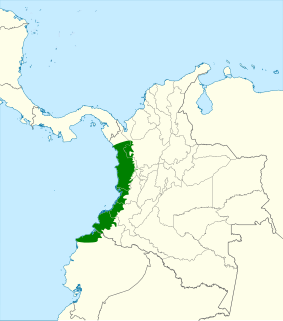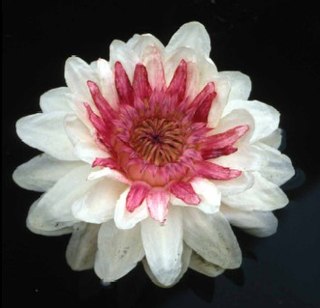
Pouteria is a genus of flowering trees in the gutta-percha family, Sapotaceae. The genus is widespread throughout the tropical regions of the world. It includes the canistel, the mamey sapote, and the lucuma. Commonly, this genus is known as pouteria trees, or in some cases, eggfruits.
Atelopus chocoensis, the Chocó stubfoot toad, is a species of toad in the family Bufonidae endemic to Colombia. Its natural habitat is subtropical or tropical moist montane forests. It is threatened by habitat loss.
Hyloxalus chocoensis, sometimes known as the Choco rocket frog, is a species of frog in the family Dendrobatidae. It is found in western Colombia to east-central Panama. In Colombia it is known from Chocó, Valle del Cauca, and Antioquia. Anomaloglossus confusus from northwestern Ecuador were formerly confused with this species, but the identity of many other populations remains uncertain. Taxonomic uncertainty hampers knowledge about the species.

The Chocó tapaculo is a species of bird in the family Rhinocryptidae. It is found in Colombia, Ecuador, and Panama.

The Chocó woodpecker is a species of bird in the family Picidae. It is found in Colombia and Ecuador. Its natural habitat is subtropical or tropical moist lowland forests. It is threatened by habitat loss from deforestation.

The Choco broad-nosed bat is a species of bat in the family Phyllostomidae. It is native to Colombia, Panama, and Ecuador, where it is found in the Choco region lowlands. It is threatened by habitat loss. In 2013, Bat Conservation International listed this species as one of the 35 species of its worldwide priority list of conservation.
Anthodiscus chocoensis is a species of plant in the Caryocaraceae family. It is found in Colombia, Costa Rica, and Panama. It is threatened by habitat loss.
Pouteria altissima is a species of plant in the family Sapotaceae, and a source of anigre hardwood. It is found in Burundi, Cameroon, Central African Republic, the Republic of the Congo, the Democratic Republic of the Congo, Ivory Coast, Ethiopia, Gabon, Ghana, Guinea, Kenya, Nigeria, Rwanda, Sierra Leone, Sudan, Tanzania, and Uganda. It is threatened by habitat loss.
Pouteria arguacoensium is a species of plant in the family Sapotaceae. It is endemic to Colombia.
Pouteria collina is a species of plant in the family Sapotaceae. It is found in Colombia and Ecuador.
Pouteria decussata is a species of plant in the family Sapotaceae. It is endemic to Brazil.
Pouteria espinae is a species of plant in the family Sapotaceae. It is endemic to Colombia.
Pouteria gigantea is a species of plant in the family Sapotaceae. It is endemic to Ecuador.
Pouteria hotteana, the redmammee, is a species of plant in the family Sapotaceae. It is found in Haiti and Puerto Rico.
Pouteria juruana is a species of tree in the family Sapotaceae. It is native to North and South America.
Pouteria longifolia is a species of plant in the family Sapotaceae. It is found in Bolivia and Peru.
Pouteria peruviensis is a species of plant in the family Sapotaceae. It is endemic to Peru.
Pouteria platyphylla is a species of plant in the family Sapotaceae. It is found in Brazil and Peru.
Pouteria puberula is a species of plant in the family Sapotaceae. It is endemic to Venezuela.

The Flora of Colombia is characterized by over 28,000 species of green plants.





